DRIVING ADVICE, ECO-DRIVING
Fuel consumption is accredited in accordance with a standard regulatory method. Identical for all manufacturers, this enables vehicles to be compared with one another. Consumption in real time depends on vehicle usage conditions, the equipment fitted and the user’s driving style. To optimise fuel consumption, please refer to the following advice.
Depending on the vehicle, you will have various functions which enable you to lower your fuel consumption:
- the rev counter ECO zone;
- gear change indicator;
- the journey record and eco-driving advice via the multimedia display;
- ECO mode activated by the ECO button;
- the Stop and Start function (refer to “Stop and Start Function” in section 2).
If fitted on the vehicle, the navigation system provides additional information.
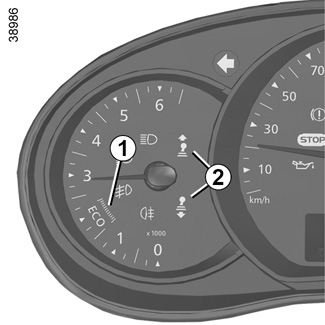
The rev counter ECO zone 1
Driving in ECO zone mode helps to optimise fuel consumption.
Gear change indicator 2
Depending on the vehicle, to obtain optimum consumption levels, a warning light on the instrument panel lets you know the best time to move up or down a gear:
Š upshift a gear;
‰ move down a gear.
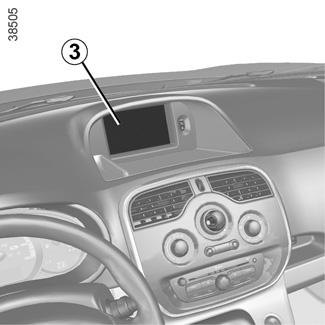
Journey record
Once the engine is switched off, you will see “Journey record” displayed on the screen 3, enabling you to view information relating to your last journey.
This indicates:
- average fuel consumption;
- number of miles/kilometres travelled;
- number of miles/kilometres saved.

ECO mode
ECO mode is a function which optimises fuel consumption. It acts on certain consumer systems in the vehicle (power-assisted steering etc.) and on certain driving actions (acceleration, gear change, cruise control, deceleration etc.).
Activating the function
Press switch 4.
The warning light in the 4 switch lights up.
While driving, it is possible to exit the ECO mode temporarily in order to improve engine performance.
To do this, press the accelerator pedal firmly and fully.
ECO mode is reactivated when you take pressure off the accelerator pedal.
Disabling the function
Press switch 4.
The indicator light in the switch 4 goes out.
Depending on the vehicle, the function is active every time the engine is started. A label is attached to the dashboard to notify you.
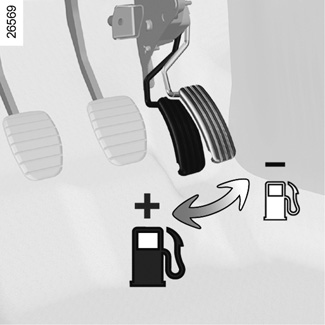
Driving advice and ECO driving
Behaviour
- Drive carefully for the first few miles until the engine reaches its normal operating temperature, rather than let it warm up while the vehicle is stationary.
- Speed is expensive.
- Sporty driving uses a lot of fuel: drive with a light right foot.
- Do not overrev the engine in the intermediate gears.
You should always use the highest gear possible.
- Avoid sudden acceleration.
- Brake as little as possible. If you anticipate an obstacle or bend in advance, you may then simply release the accelerator pedal.
- Do not try to maintain the same speed up a hill, accelerate no more than you would on the level. Keep your foot in the same position on the accelerator pedal.
- Double declutching and accelerating before switching off are unnecessary in modern vehicles.
- Bad weather, flooded roads:
| Do not drive through floods if the water is above the lower edge of the wheel rims. |
Obstructions to the driver
On the driver’s side, only use mats adapted to the vehicle that attach to the preinstalled parts, and regularly check their mounting. Do not place several mats on top of each other.
There is a risk of wedging the pedals
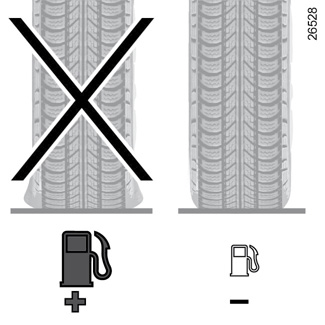
Tyres
- An underinflated tyre increases fuel consumption.
- The use of non-recommended tyres can increase fuel consumption.
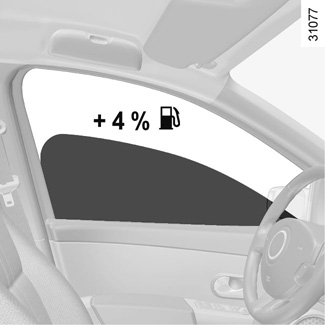
Advice on use
- Favour the ECO mode.
- Electricity is fuel; switch off all the electrical components which are not really needed. However (safety first), keep your lights on when the visibility is bad (“see and be seen”).
- Use the air vents. Driving with the windows open at 60 mph (100 km/h) will increase fuel consumption by 4%.
- Never fill the fuel tank right to the brim to avoid overflow.
- In vehicles fitted with air conditioning, it is normal to observe an increase in fuel consumption (especially in urban conditions) when it is used. For vehicles fitted with manual air conditioning, switch off the system when it is not required.
Advice for reducing consumption and helping to preserve the environment
- If the vehicle has been parked in the sun, open the doors for a few moments to let the hot air escape before starting the engine.
- Do not leave an empty roof rack fitted to the vehicle.
- When towing a caravan, fit a wind deflector and adjust it carefully.
